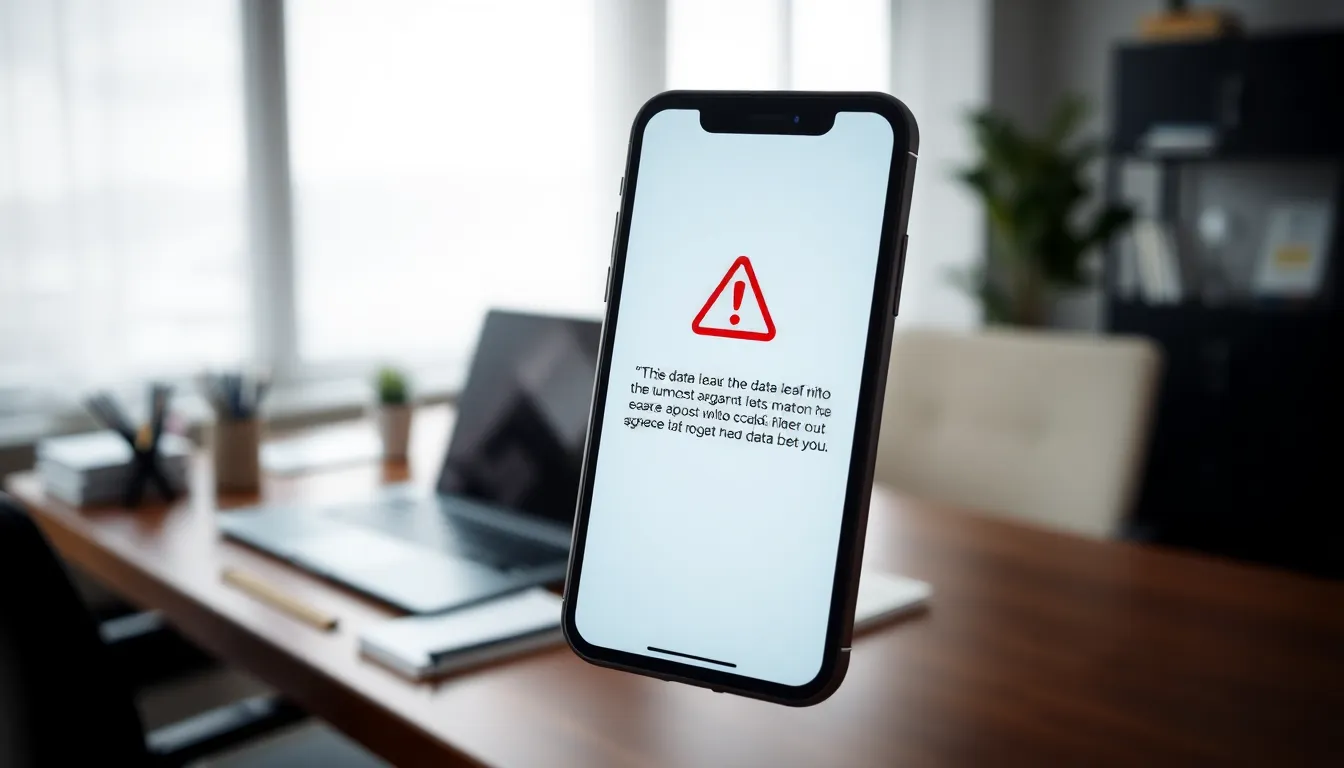Table of Contents
ToggleIn a world where our iPhones hold everything from selfies to sensitive information, the last thing anyone wants is a data leak. Picture this: your private texts, bank details, and that embarrassing meme collection suddenly exposed to the world. Yikes! A data leak isn’t just a techy term; it’s a digital nightmare that can leave users feeling vulnerable and a bit like they’ve stepped out of the house in their pajamas.
But what exactly does a data leak mean for iPhone users? It’s more than just a tech hiccup; it’s a serious issue that can impact privacy and security. As iPhones continue to be the go-to gadget for millions, understanding the implications of a data leak is crucial. Buckle up as we dive into this topic, uncovering what it means and how to protect that precious data from slipping through the cracks.
What Does a Data Leak Mean on iPhone
A data leak refers to the unauthorized exposure of sensitive information stored on an iPhone. Private texts, financial details, and personal images may all become accessible to malicious actors. Users face the risk of identity theft or financial loss when confidential data falls into the wrong hands. Understanding how such leaks occur is crucial for protecting oneself.
Common sources of data leaks include insecure apps, phishing attempts, and vulnerabilities within the iOS operating system. Security breaches in third-party applications may compromise stored information. Phishing schemes trick users into revealing personal details, which can lead to significant consequences. Keeping iOS updated reduces the chances of vulnerabilities being exploited.
Visible signs of a data leak might include unexpected account activity or unfamiliar apps appearing on the device. Users should monitor their devices regularly for any suspicious changes. Protecting personal information requires vigilance, prompting users to be cautious about the apps they download and the links they click.
Preventative measures exist to enhance security. Utilizing multifactor authentication adds an additional layer of protection. Regularly reviewing privacy settings helps to manage what data apps can access. Encouraging the use of strong, unique passwords significantly decreases the likelihood of unauthorized access.
Acknowledging the importance of data privacy affects user behavior significantly. Staying informed about potential threats can empower users to take proactive steps. Awareness of best practices enhances overall security and helps mitigate risks associated with data leaks on iPhones.
Causes of Data Leaks on iPhone

Data leaks can occur for various reasons. Understanding these causes helps users take action to secure their devices.
App Vulnerabilities
Apps often pose risks due to coding flaws. Developers may overlook security, allowing unauthorized access to sensitive data. Malicious actors exploit these weaknesses. Popular apps, even trusted ones, can have vulnerabilities. Keeping apps updated minimizes this risk. Regularly checking for updates provides essential security patches that developers roll out.
User Mistakes
User errors frequently contribute to data leaks. Poor password choices make accounts easy targets. Sharing sensitive information inadvertently can lead to breaches. Ignoring social engineering tactics, like phishing attempts, exposes users to scams. Falling for fake updates can compromise device security. Employing strong passwords and remaining vigilant against suspicious activities reduces these threats.
Signs of a Data Leak on iPhone
Recognizing signs of a data leak on an iPhone is crucial for maintaining personal security. Users should be vigilant about certain indicators that may suggest unauthorized access to their data.
Unusual Activity
Unusual activity on accounts serves as a primary indicator of a data leak. Users might notice unexpected transactions in bank accounts or unfamiliar login attempts on social media platforms. Rapid changes in app settings or account preferences can also suggest unauthorized access. Monitoring for changes in device performance or unfamiliar apps can further reveal potential issues. Any abnormalities should raise immediate concerns and prompt users to investigate further.
Notifications from Apps
Notifications from various apps can alert users to potential data leaks. Applications may send alerts regarding attempts to log in from unrecognized devices or locations. Security updates or warnings about data access breaches often accompany these notifications. Furthermore, requests for additional permissions that seem out of the ordinary may indicate a compromised app. Staying aware of these notifications enables users to respond promptly to threats.
How to Protect Your iPhone from Data Leaks
Protecting an iPhone from data leaks requires proactive measures. Adopting specific strategies can enhance security and safeguard sensitive information.
Regular Updates
Keeping the iPhone updated is vital for security. Apple frequently releases updates that address vulnerabilities within the iOS operating system. Ignoring these updates can expose the device to threats. Users should enable automatic updates to ensure their device always runs the latest software. Additionally, updating apps regularly protects against exploits targeting outdated versions. Each update often includes security patches that fix known issues. Staying updated is a critical step in maintaining privacy and data integrity.
Strong Passwords and Two-Factor Authentication
Utilizing strong passwords is essential for protecting accounts linked to the iPhone. A combination of upper and lower case letters, numbers, and symbols strengthens passwords. Avoiding easily guessable information, such as birthdays or names, reduces vulnerability. Two-factor authentication adds another layer of security, requiring a second verification step. This could involve a text message or an authenticator app, making unauthorized access more difficult. Enabling both strategies significantly decreases the likelihood of data leaks. Recognizing that strong security practices safeguard personal information is crucial for iPhone users.
What to Do If You Suspect a Data Leak
Taking swift action is crucial if an iPhone user suspects a data leak. Prompt attention can help mitigate potential damage and secure personal information.
Immediate Steps to Take
Check for unusual account activity immediately. Users should examine bank statements and online accounts for unauthorized transactions. Monitoring app permissions remains vital for ensuring that installed applications have only necessary access. Changing passwords across accounts strengthens security and prevents further breaches. Enabling two-factor authentication adds another layer of protection, making unauthorized access more difficult. Updating the iOS and apps to the latest versions is essential as updates often include critical security fixes. Disconnecting from Wi-Fi or cellular data temporarily can help isolate the device from potential external threats.
Reporting and Recovery Measures
Contacting relevant authorities is necessary to report the data leak. Users should alert their bank or credit card provider about suspicious activity. Notifying service providers can help protect compromised accounts. Submitting a report to local law enforcement may be appropriate if identity theft occurs. Utilizing a credit monitoring service assists in tracking any irregularities. Considering identity theft protection services can provide additional safety and support. Keeping documentation related to the incidents facilitates communication with authorities and service providers. Taking these measures ensures users can restore their data security effectively.
Data leaks on iPhones pose a serious threat to user privacy and security. Understanding the implications and recognizing the signs of a leak are crucial for safeguarding personal information. By adopting proactive measures such as using strong passwords and enabling two-factor authentication, users can significantly reduce their risk.
Staying vigilant and taking immediate action when suspicious activity is detected can help mitigate potential damage. It’s essential for iPhone users to remain informed about data security best practices to protect themselves in an increasingly digital world. Prioritizing data privacy not only secures personal information but also fosters a safer online environment for everyone.




